Exploring The Bats Of Nicobar
First published in Sanctuary Asia,
Vol. 43
No. 4,
April 2023
Photographs and Text by Bandana Aul Arora
In the world I grew up in, dolls were more of an interest for young girls, but even as a child I was more interested in exploring the outdoors. The first time I heard the roar of a tiger, in a zoo, stirred something in me. I just had to look for one in the wild and thus began my fascination for the Felidae, particularly the big cats. In 2001, I travelled to the Nicobar Islands as part of my Master’s degree and was tasked with the challenge of locating and studying the bats of the mysterious islands. I could find no one who had studied bats here before, and my focus thus shifted from cats to bats!
I have, of course, often been asked why I chose to study bats. Depending on my mood, my answers have varied from “Because bats hang upside and look at life from the right perspective,” to “I am not a morning person, so I chose a nocturnal species.” Truth be told, I have long held a fascination for caves and have always been interested in delving into the obscure. My first experience of caves was in the Rutland Island, South Andaman, along with Dr. Ravi Sankaran and Sanctuary’s editor, Bittu Sahgal, wherein as a novice, I was denied entry into the caves. I made a promise to myself that one day, I would explore them all! Today, I can confidently say that I kept that promise; I have surveyed more than 300 caves in the Andaman and Nicobar Islands.
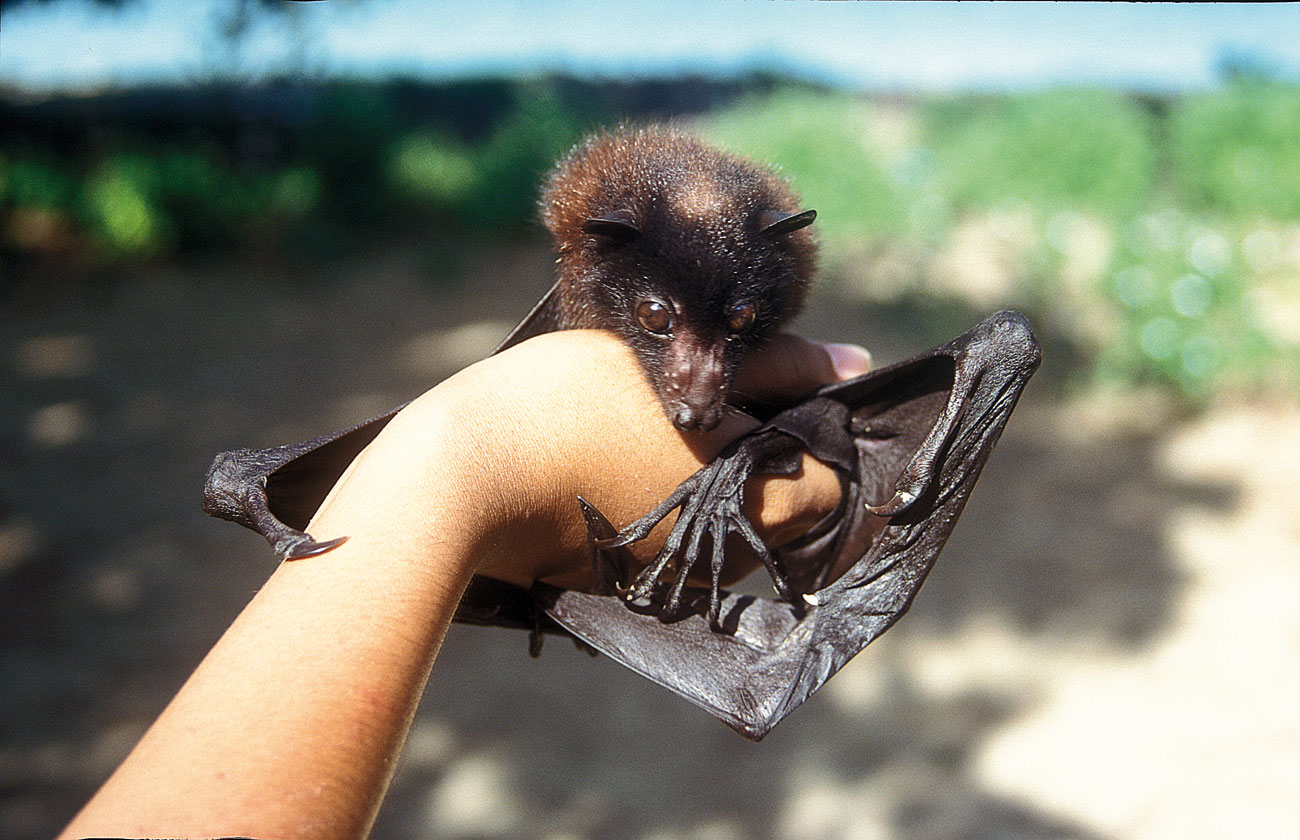
During her studies, the author came across an orphaned juvenile black-eared fying fox Pteropus melanotus, found only in Andaman, Nicobar and Sumatra.
The Batting Life
My adventurous, memorable and often challenging work in the Nicobar Islands began at the southernmost tip – the Great Nicobar Island (GNI) – in 2002. A three-day journey of 528 km. by ship was the only mode of travel to the islands then. All travel begins early in the morning as the tides across the 10-degree channel are not navigable later in the day. The ship travels from Port Blair via Hut Bay (Little Andaman), Car Nicobar, Tressa (pronounced as Taa-rasa), Kamorta and then we would make landfall at Campbell Bay. While travelling, we would joke about landing a little south in the islands of Sumatra and being deported back to India – that would have been one easy plane ride back home! At that time, communication was by snail mail, via letters, and an occasional phone call courtesy a vintage pay phone booth (if the owner was not asleep by the time you came back from your field trip). There were no mobile phones… no connectivity at all.
I remember the first of my trips. My assistant, Saw Johnny and I, reached Campbell Bay and checked into the forest house with a friend. Almost immediately, I felt like I had arrived at my second home. Working on the remote island somehow always seemed secure. I spent a lot of time in the mangroves and the jungles. The islanders never made me feel ‘unsafe’, even in the initial days, when they did not know me, thanks to the tribal ethos that fosters a genuine respect for women. I cannot imagine feeling as safe and free working almost anywhere else.
_C-1300_1680759095.jpg)
The lesser short-nosed fruit bat Cynopterus brachyotis is a frugivorous bat found in South and Southeast Asia.
The Forest Department officials and islanders were equally courteous. Being the only woman researcher on the islands, I got extra support from them and after they saw us working through the night to protect their forests, the association between us grew strong and they would then go out of their way to make me feel at home. The Gol Ghars (round-shaped family houses on stilts) were opened up for me; they would place guards for my field trips to the interiors of the islands, especially when my work took me to Kopenheat (the Western border of Great Nicobar Island), as it goes through the East-West Road from Campbell Bay – via the Shompen Hut. When we were out for weeks in the forest, the islanders would call my mother and tell her that all was well with me. Often on returning, I would learn of multiple calls made to my mother from the island, as most of them assumed the duty to ensure that my parents would sleep in peace.
Prior to my arrival on the islands, the effort to systematically map the bat fauna in the bay islands had never been attempted. I successfully documented 17 species in the Andaman group and 12 in the Nicobar group. Whilst recording species and ecological information on the roosting habitats, diet and threats faced by bats, we also recorded severe pressure on their populations on account of habitat degradation and change, human settlements, introduction of exotics and enhanced activity in the islands.
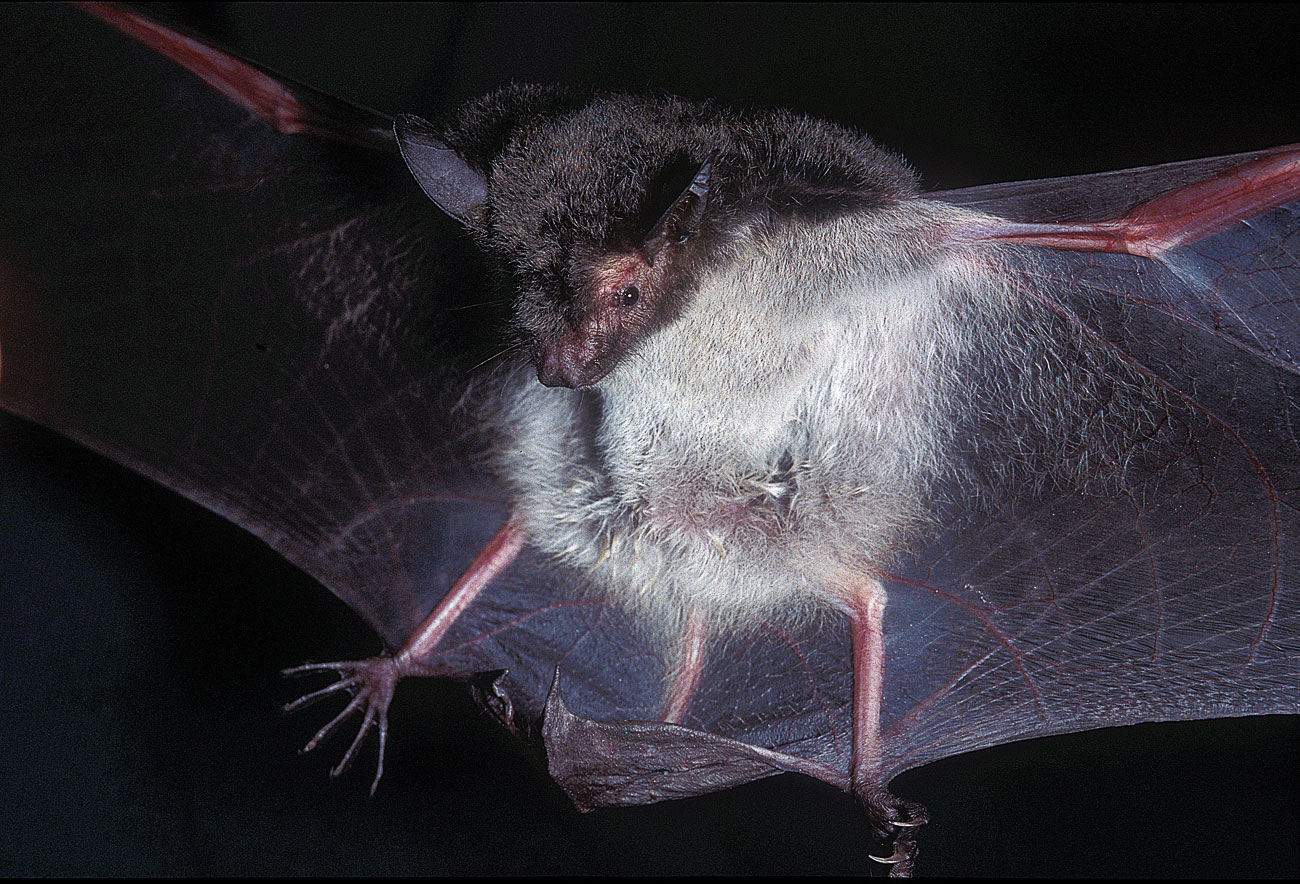
The author recorded 12 bat species from the Nicobars including Myotis dryas of family Vespertilionidae.
As my work progressed, south of the 10-degree channel in the Nicobar Islands, I commenced the survey from GNI. It took me six years to map the habitat and distribution of bat fauna of the 24 islands that formed the archipelago.
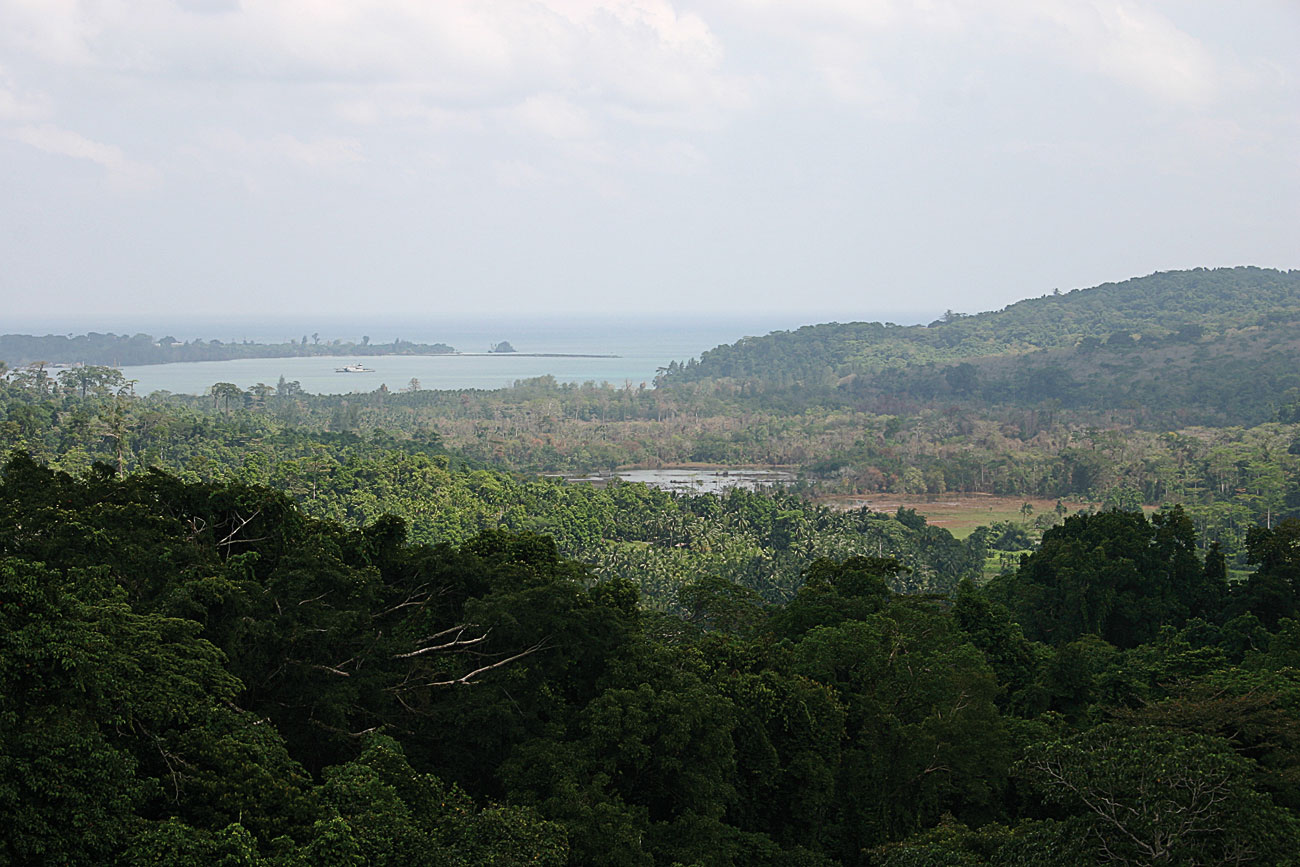
A view of Campbell Bay in Great Nicobar. The author surveyed Great Nicobar, Little Nicobar, Kondul and the Pulo Milo islands. She followed up her work in Central Nicobar comprising eight islands, Nancowrie, Kamorta, Katchal, Trinket, Tressa, Bompuka, Chowra, and Tillangchong, and then moved to northern Nicobar comprising the Car Nicobar Islands.
Great Nicobar Island
Islands seem to have it all: ample sunshine, white sand beaches, and species you can’t find anywhere else on Earth. Since Charles Darwin first traveled to the Galápagos Islands and British naturalist Alfred Russel Wallace to the Malay Archipelago in the mid-19th century, ecologists have believed there is something special about islands. A new study provides some of the first empirical evidence that island biodiversity really is different from that of the mainland.
– Carrie Arnold, in ScienceNOW
Most of Great Nicobar is designated as a biosphere reserve. The biosphere reserve incorporates two national parks, which were gazetted in 1992. Campbell Bay National Park on the northern part of the island and Galathea Bay in the southern interior are well known as traditional nesting places for giant leatherback turtles. In 2013, it was included in UNESCO’s Man and Biosphere Programme to promote sustainable development. The Great Nicobar Biosphere Reserve harbours a wide spectrum of ecosystems comprising tropical wet evergreen forests, mountain ranges, and coastal plains. The region has recorded a host of ecologically important species of flora and fauna, including angiosperms, ferns, gymnosperms, bryophytes and lichens, among others. The area fosters several rare and endemic species, including the crab-eating macaque, Nicobar treeshrew, dugong, Nicobar Megapode, Nicobar Serpent Eagle, saltwater crocodile, marine turtles and the reticulated python, which are/or might be endangered (there is a lack of sufficient data). Bats have not been included in the list, as there has been no work done on them in the past. Much of the existing information on bats in the Andaman and Nicobar Islands was restricted to sporadic surveys and mere chance encounters.
While our work contributed to some extent, conservation in the islands cannot be initiated to its full impact until most of the species are documented and their habitats are recorded and mapped. A striking example is when we were able to document the Nicobar Scops Owl Otus alius on a bat sampling night, which had not been photographed before.
Destination Great Nicobar
My survey of the bats of the Nicobar Islands resulted in interesting data. This included the rediscovery of the only endemic, solitary roosting Pteropus faunulus, and a medium-sized flying fox Myotis horsfeildii dryas. Murina cyclotis was also reported for the first time in Great Nicobar. This is a new range for records of bat species in these islands.
By 2007, I had completed my survey in the southern Nicobar group, comprising Great Nicobar, Little Nicobar, Kondul and the Pulo Milo islands. I then followed by working in Central Nicobar comprising eight islands, Nancowrie, Kamorta, Katchal, Trinket, Tressa, Bompuka, Chowra, and Tillangchong. And then moved to northern Nicobar comprising the Car Nicobar Islands.
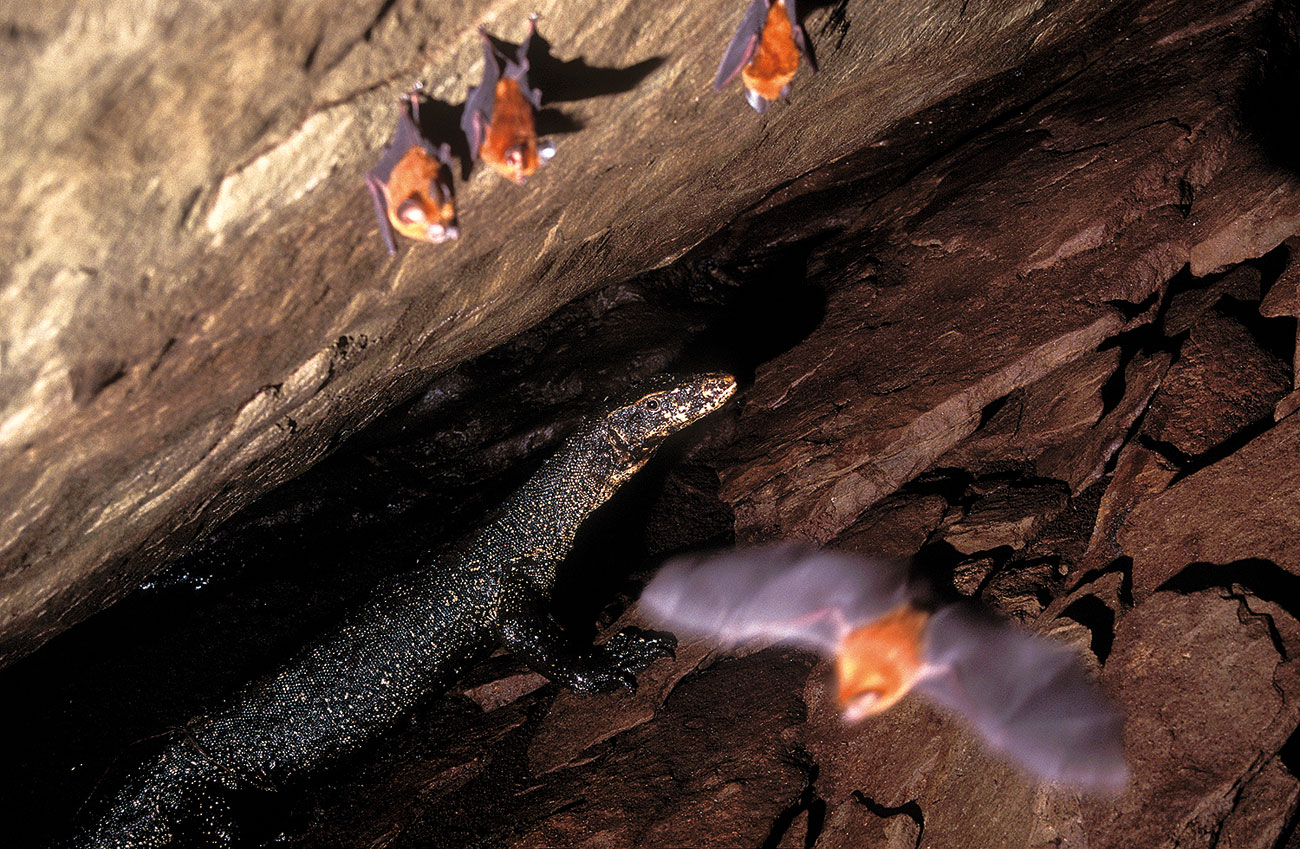
A monitor lizard climbs the steep walls of a cave in seacrch of some Hipposideros species bats.
I largely explored Great Nicobar on foot, with Johnny, my field assistant, who helped me lug camera, data books and sampling equipment. We shuttled between islands using a small boat, called a dungi. Initially, we had to hitch-hike with the local fishermen until we got one for ourselves. Once, on an early and rainy morning, we hitchhiked to Kondul island from Campbell Bay with the local fishermen. At night, I dreamt of white elephants, and the islanders said it meant that there will be more rain. Lo and behold… it rained continuously all the seven days we were there. No bat-related work got done! But we did swim into the sea-shore caves in Kondul and found Taphozous sp inside. A week later it was time to head back to Campbell Bay in the same dungi. Sensing my disappointment, the local fishermen kindly promised to take me there again when it wasn’t raining.
_C-1300_1680760233.jpg)
A lesser short-nosed fruit bat pup hangs on to its mother’s belly. Bat mothers routinely carry their pups, almost one third their own weight, while the pups cling to her underarm nipple and hold on to her waist with their toes.
Megabats of Great Nicobar
Pteropus melanotus: This medium-sized fruit bat is the largest species of bat, weighing around 619.8 g. The pelage is dark brown to blackish brown, with paler hair sometimes giving it a grizzled appearance. The back and rump are blackish, sprinkled with a few grey hair. The mantle is rufous in males and lesser or absent in females. The day roosts have a dominant habitat in the mangrove creeks and the fronds of nypa palms. Pteropus melanotus (n>500) was found to be roosting in Nypa fruticans palm fronds primarily, with a minimum of 10-15 bats on a single plant. The colony in Great Nicobar Island (n>300) was initially located at the head of the creek but frequent human intervention has forced them to the interiors of the creek.
Cynopterus brachyotis: A small fruit bat weighing 56.9 g. The white margins bordering the ear are very prominent and run all along the ear uniformly. It is the most widely and commonly occurring bat across all habitats on the islands. This species is found in several different habitats, mainly mangrove fringes, dry evergreen forests, human habitation and evergreen forests. The bats were particularly observed to frequently visit fruit plantations and in some areas were reported to be damaging to the plantations. They are often seen to roost under the leaves of coconut trees by making tents either in groups or solitarily. They are voracious foragers and begin foraging early in the evening and continue until dawn. A distinct click - click sound can be heard while they move from tree to tree for foraging.
The Classification of Bats
Interestingly, the classification of bats into the order Microchiroptera and Megachiroptera is not based on size! Some microbats are actually larger than the fruit-eating megabats. Microbats primarily use larynx echolocation for navigation and to find prey. The one exception is the Egyptian fruit bat, which uses a type of echolocation by clicking its tongue.
The Microchiroptera or insectivorous bats in the islands are poorly described in past literature of the islands. A total of 12 species of bats belonging to eight genera and four families from the Nicobar Islands have now been recorded. A majority (75 per cent) of the bat species belong to the sub-order Microchiroptera. Leaf-nosed microbats are represented by two cryptic species – Hipposideros ater nicobarulae and Hipposideros pomona. Both are small bats and occupy caves and road culverts or abandoned buildings. These are difficult to distinguish and only morphometric data marginally separate them along with their occupancy in separate areas with no overlay together. The caves – the most important roosting habitats for bats, are also inhabited by Edible Nest Swiftlets Collocalia fuciphagus, which make them susceptible to disturbance as the nest is of economic value.
Megachiroptera on the other hand is represented by three species, namely Cynopterus brachyotis and the endemic Pteropus faunulus, restricted to the Central Nicobar Islands. and Pteropus melnotus is restricted to mangrove forests in Great Nicobar and other islands in the Nicobar Islands.
Needless to add, I returned to the Islands several times. One of my favourite flying mammal study groups were the microbats (Microchiroptera).
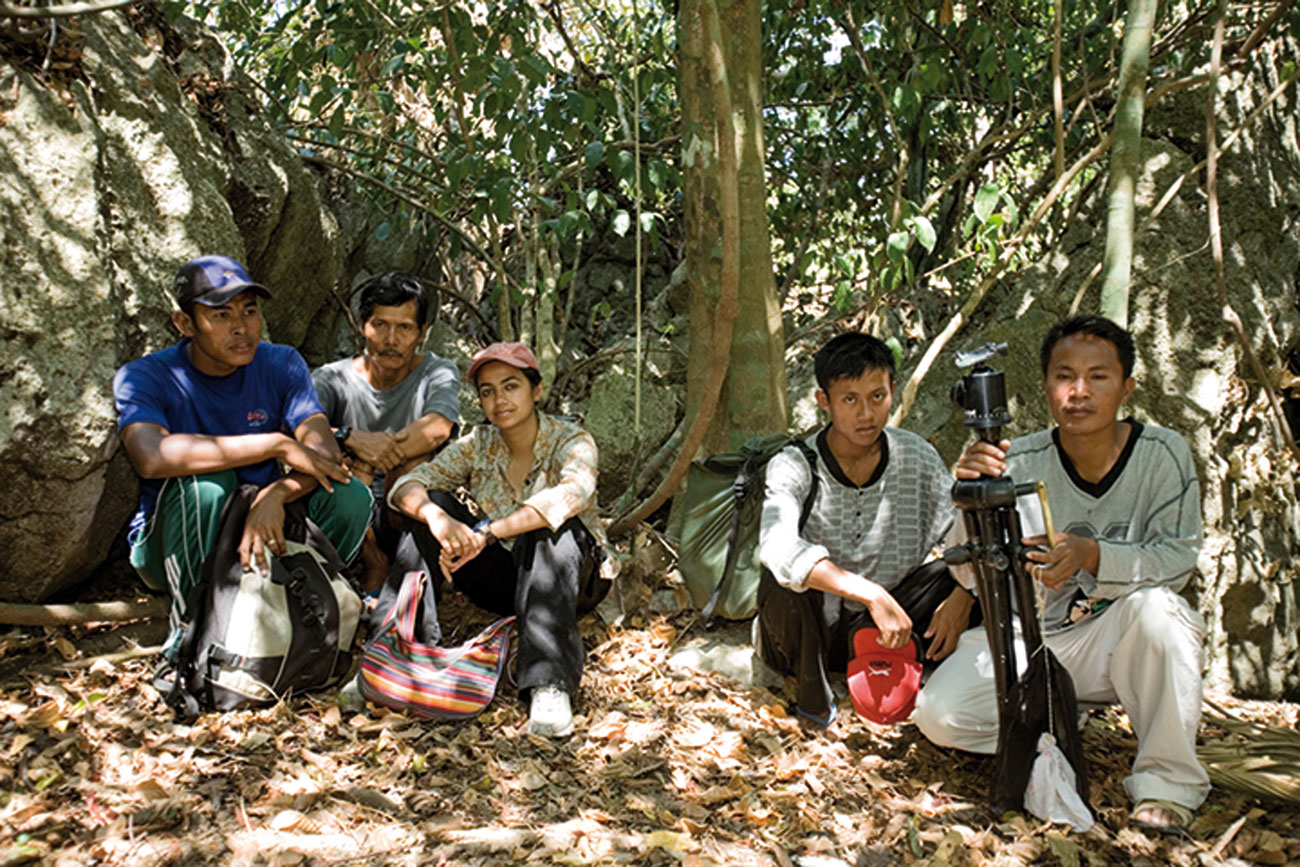
The author and her team take a much needed break during field work in the Nicobars.
The Island Tale
Great Nicobar is the largest island in the Nicobar group and is inhabited by two Indigenous tribes, the Shompen and Nicobarese. The Shompen tribes live in the dense interior parts of the reserve forest, leading a semi-nomadic life and are restricted to Great Nicobar. They are hunter gatherer tribes and maintain limited contact with the outside world. The Nicobarese on the other hand have settled in all the islands in the Nicobar group. They are coastal dwellers who subsist on coconut plantations. A local legend about bats was that once upon a time, an old lady was unwell and the cold weather was making it worse for her to survive. A well-wisher offered the lady his blanket to keep her warm. Eventually, the days grew warmer, but by now, the blanket had become a part of the lady’s back. Feeling unattractive with the blanket stuck to her back, the lady began to only venture out at night, when everyone was fast asleep. Till date, she roams and protects the forests at night.
Microbats in the Great Nicobar Island and Their Habitats
Taphozous melanopogon: cave dwelling
Hipposideros pomona: caves, abandoned buildings
Hipposideros ater nicobarulae: caves and culverts
Myotis horsfieldii dryas (endemic): roosting site not found
Murina cyclotis (newly recorded): roosts in foliage
Protecting Bats Of Great Nicobar
Anthropogenic factors are, sadly, poised to rob the islands of their unique, under studied, sensitive and irreplaceable ecosystem, which evolved over millions of years. Take the example of endemic flying foxes on the islands. If they go extinct, no amount of reintroduction efforts will succeed because this species shares a unique interdependence with the islands’ flora and fauna. No other part of the world possesses this and we have not even scratched the surface of research required to document the islands’ biodiversity.
-1300_1680760644.jpg)
Sanctuary’s Editor Bittu Sahgal with the author during her survey of bats in the Nicobar Islands.
The primary threat to bats, wherever they are found, is roost disturbance and habitat degradation. Some instances of hunting by locals does take place. But community-led initiatives to monitor foraging sites and roosting sites near human-occupied areas helps. And, when combined with more frequent and rigorous scientific research, we are beginning to understand the immense ecological services these oft-maligned mammals offer. A ban on any hunting by working together with the community to mitigate threats to cave systems and other roosting sites needs to be prioritised. But these days, we hear of several developmental projects planned for the Great Nicobar and I worry that we could lose species even before they have been fully studied. Some reports suggest that over a million trees might be felled. Irrespective of any mitigation steps suggested, being an island, this cannot bode well for bats, or virtually any other species on the Great Nicobar Island because the vast bulk of extinctions that have taken place in the past centuries have, you guessed it, been on islands that offered species in distress no retreat.

_C-1920.jpg)

_C-1300_1680759095.jpg)



_C-1300_1680760233.jpg)

-1300_1680760644.jpg)